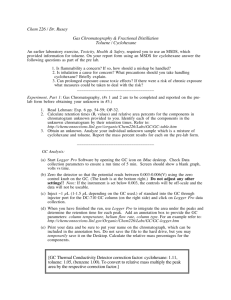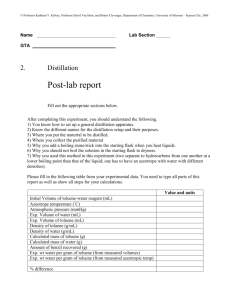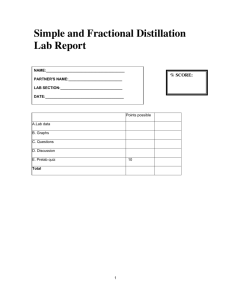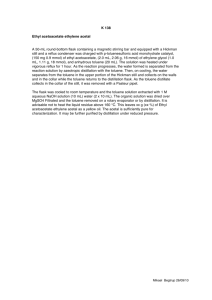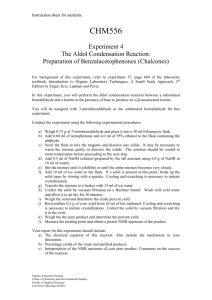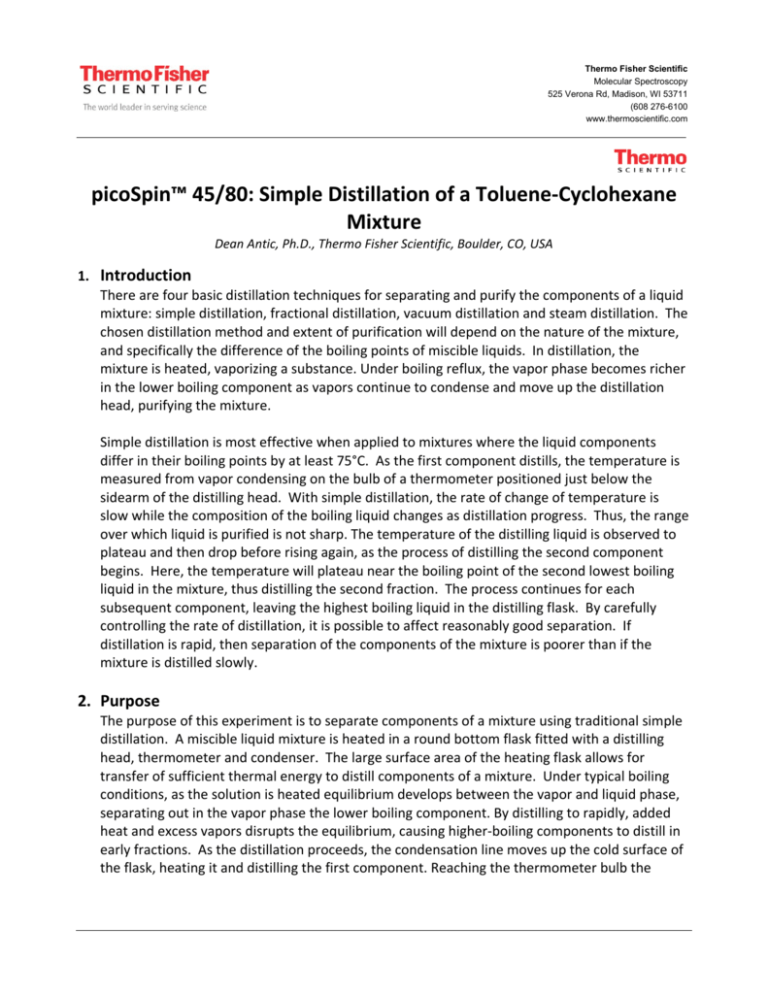
Thermo Fisher Scientific
Molecular Spectroscopy
525 Verona Rd, Madison, WI 53711
(608 276-6100
www.thermoscientific.com
picoSpin™ 45/80: Simple Distillation of a Toluene-Cyclohexane
Mixture
Dean Antic, Ph.D., Thermo Fisher Scientific, Boulder, CO, USA
1. Introduction
There are four basic distillation techniques for separating and purify the components of a liquid
mixture: simple distillation, fractional distillation, vacuum distillation and steam distillation. The
chosen distillation method and extent of purification will depend on the nature of the mixture,
and specifically the difference of the boiling points of miscible liquids. In distillation, the
mixture is heated, vaporizing a substance. Under boiling reflux, the vapor phase becomes richer
in the lower boiling component as vapors continue to condense and move up the distillation
head, purifying the mixture.
Simple distillation is most effective when applied to mixtures where the liquid components
differ in their boiling points by at least 75°C. As the first component distills, the temperature is
measured from vapor condensing on the bulb of a thermometer positioned just below the
sidearm of the distilling head. With simple distillation, the rate of change of temperature is
slow while the composition of the boiling liquid changes as distillation progress. Thus, the range
over which liquid is purified is not sharp. The temperature of the distilling liquid is observed to
plateau and then drop before rising again, as the process of distilling the second component
begins. Here, the temperature will plateau near the boiling point of the second lowest boiling
liquid in the mixture, thus distilling the second fraction. The process continues for each
subsequent component, leaving the highest boiling liquid in the distilling flask. By carefully
controlling the rate of distillation, it is possible to affect reasonably good separation. If
distillation is rapid, then separation of the components of the mixture is poorer than if the
mixture is distilled slowly.
2. Purpose
The purpose of this experiment is to separate components of a mixture using traditional simple
distillation. A miscible liquid mixture is heated in a round bottom flask fitted with a distilling
head, thermometer and condenser. The large surface area of the heating flask allows for
transfer of sufficient thermal energy to distill components of a mixture. Under typical boiling
conditions, as the solution is heated equilibrium develops between the vapor and liquid phase,
separating out in the vapor phase the lower boiling component. By distilling to rapidly, added
heat and excess vapors disrupts the equilibrium, causing higher-boiling components to distill in
early fractions. As the distillation proceeds, the condensation line moves up the cold surface of
the flask, heating it and distilling the first component. Reaching the thermometer bulb the
vapor-phase temperature is measured just before it condenses and liquefies in an air or watercooled condenser tube. Condensed, purified liquid then flows to a collection flask.
In this experiment, a 50:50 mixture of cyclohexane and toluene will be distilled, separating the
lower boiling component from the mixture. The initial mixture, the distillate and the pot
residue will be analyzed using the Thermo Scientific™ picoSpin™ 45 or 80 NMR spectrometer.
Samples will be quantified but integrating resonance signals in the spectra to determine the
molar ratio of the initial mixture, distillate and pot residue, and to evaluate the efficiency of
simple distillation of our choice of liquid samples.
3. Literature
Adapted from Williamson, K. L.; Minard, R.; Masters, K. M. Macroscale and Microscale Organic
Experiments, 5th ed., Houghton Mifflin Co., 2007.
4. Pulse Sequence
In this experiment, we use a standard 90° single pulse experiment. The recycle delay time (d1)
is adjusted to maximize signal intensity prior to signal averaging the next FID.
Sequence: d1−[ °−aq−d1]ns
°: Pulse rotation angle (flip angle)
FID: Free induction decay
d1: Recycle delay (µs) for spin-lattice
relaxation
p1: R.F. transmitter pulse length (µs)
aq: Acquisition time (ms)
ns: # of scans (individual FIDs)
2
5. Procedures and Analysis
Time requirements: 2 hrs
Difficulty: Easy
Sample: Cyclohexane, toluene
Equipment/materials:
• Thermo Scientific™ picoSpin™ 45 or 80
• Cyclohexane (C6H12)
• Toluene (C5H5CH3)
• Tetramethylsilane (TMS; (CH3)4Si)
• Simple distillation apparatus
• 100 mL round bottom flask
• 25 mL Erlenmeyer flask
• Condenser
• Three-way adapter
• Vacuum adapter
• Clamps (flask or Keck)
• Ring stand, ring clamp, iron ring
• Thermometer
• Thermometer adapter
• Boiling chips
• Mnova NMR Processing Suite
• picoSpin accessory kit:
• Port plugs
• Syringe port adapter
• Drain tube assembly
• 25 mL beaker
• 1 mL polypropylene syringes
• 22 gauge blunt-tip dispensing needles
• 2 and 7 mL vials
Molecules:
Physical data:
Substance
toluene
cyclohexane
tetramethylsilane (TMS)
chloroform-d (CDCl3) w/1%TMS
acetone-d6 (Ac-d6) w/ 1%TMS*
*Optional NMR solvents
FW (g/mol)
92.14
84.16
88.22
120.384
64.12
Quantity
10 mL
10 mL
3 drps
1 mL
1 mL
MP (°C)
-95
6.47
-99
-64
-94
BP (°C)
111
80.74
26-28
61
56
Density (g/mL)
0.8669
0.779
0.648
1.50
0.872
3
Safety Precautions
CAUTION Eye protection should be worn at all times while using this
instrument.
CAUTION Avoid shock hazard. Each wall outlet used must be equipped with a 3prong grounded outlet. The ground must be a noncurrent-carrying wire connected
to earth ground at the main distribution box.
Experimental
Reaction procedure
• Set up a simple distillation apparatus (Figure 1).
Figure 1 Simple distillation apparatus
• Use a sand bath as a heat source.
• To a 50 mL round bottom flask, add approximately 10 mL of toluene, 10 mL of
cyclohexane, and a boiling chip.
• Swirl the mixture then take a 0.25 mL aliquot for Sample 3 and transfer it to a 2mL vial.
• Place the thermometer bulb so it reaches below the sidearm of the three-way adapter.
• Use water to cool the condenser.
• Place a receiving vial at the outlet of the vacuum adapter.
• Place the vial in a 25 mL beaker filled with ice.
• Control heating of the round bottom flask by piling up or removing hot sand.
4
• As distillation begins, vapors will rise and condense on the cold glass.
• Control the boiling rate by removing some sand so that only about 2 drops per minute is
collected in the receiving flask.
• Record the temperature as the first drops of liquid are collected. This temperature
reflects the boiling point of the cyclohexane distillate.
• Collect distillate until distillation of cyclohexane stops and the observed temperature
drops (approximately 7 mL)
• Do not distill to dryness.
• Turn off the sand bath.
• Prepare samples for NMR analysis
Preparing Samples
Several samples will be prepared for analysis. Samples can be analyzed as neat liquids.
Since the 1H NMR chemical shifts of toluene and cyclohexane are well known, we can use
their signals as an internal chemical shift reference. Alternatively, a few microdrops of TMS
(0 ppm) can be added to the test samples. The sample preparation guide and spectra
presented are for neat samples with added TMS.
• Sample 1: To a labeled vial measure about 0.20 mL of toluene, add a couple microdrops
of TMS. Cap and save for NMR analysis.
• Sample 2: To a labeled vial measure about 0.20 mL of cyclohexane, add a couple
microdrops of TMS. Cap and save for NMR analysis.
• Sample 3: To a labeled vial measure about 0.20 mL of the initial mixture of toluene and
cyclohexane from the round bottom flask, add a couple microdrops of TMS. Cap and
save for NMR analysis.
• Sample 4: To a labeled vial measure about 0.20 mL of distillate from the receiving flask,
add a couple microdrops of TMS. Cap and save for NMR analysis.
• Sample 5: To a labeled vial measure about 0.20 mL of residue from the round bottom
flask, add a couple microdrops of TMS. Cap and save for NMR analysis.
•
Instrumental procedure
The general procedure for sample analysis using a picoSpin NMR spectrometer is as follows:
Shim
Prepare
Inject
Acquire
Analyze
Shim
• Ensure the NMR spectrometer is shimmed and ready to accept samples.
Pre-sample preparation
• Displace the shim fluid from the picoSpin capillary cartridge with air.
5
• Flush the cartridge with 0.1 mL of chloroform, and then displace the solvent with an air
push. A small signal in your sample spectrum may appear at 7.24 ppm due to residual
chloroform, it can be used to shift reference the spectrum.
• Set up the onePulse script according to parameters listed in the Pulse Script table.
Injection
• Using a 1 mL disposable polypropylene syringe fitted with a 1.5” long, 22 gauge blunt-tip
needle, withdraw a 0.2 mL aliquot of sample.
• Inject about half the sample. Ensure all air bubbles have been displaced from the cartridge
by examining the drain tube.
• Cap both the inlet and outlet ports with PEEK plugs.
Acquire
• Execute the onePulse script according to the values in the table of parameters provided
• Once the onePulse script has finished, prepare the cartridge for the next user by
displacing the sample from the cartridge according to the following protocol: air, solvent,
air.
Pulse Script: onePulse
Acquisition parameters apply to both the picoSpin 45 and picoSpin 80 spectrometers. Use
the tx frequency (tx) and pulse length (p1) appropriate for each system.
Parameter
Value
tx frequency (tx)
proton Larmor frequency (MHz)
scans (ns)
4
pulse length (p1)
Instrument specific 90° pulse length
acquisition time (aq)
750 ms
rx recovery delay (r1)
500 µs
T1 recycle delay (d1)
6s
bandwidth (bw)
4 kHz
post-filter atten. (pfa) 10 (11)a
phase correction (ph) 0 degrees (or any value)
exp. filter (LB)
0 Hz
max plot points
400
max time to plot
250 ms
min freq. to plot
-200 Hz
max freq. to plot
+1000 Hz
zero filling (zf)
8192
align-avg. data
live plot
JCAMP avg.
JCAMP ind.
Unchecked
a
Choose the instrument’s default pfa values
6
6. Processing
Download the experimental JCAMP spectra files and open them by importing into Mnova. The
free induction decay (FID) will undergo automatic Fourier transformation and a spectrum will
be displayed. To each spectrum, apply the following processing steps using the given settings:
Function
Zero-filling (zf) & Linear Predict (LP)
Forward predict (FP)
Backward predict (BP)
Phase Correction (PH)
Apodization
Exponential (LB)
First Point
Shift reference (CS)
Peak Picking (pp)
Integration (I)
Multiplet Analysis (J)
•
•
•
•
•
Value
16 k
From aq → 16 k
From -2 → 0
PH0: Manually adjust
PH1: 0
0 Hz
0.5
Manually reference
Manually Select Peaks
Automatic Selection
-
Import each data file into the same workspace in Mnova. Manually apply Ph0 phase
correction to each spectrum.
Manually shift reference each spectrum using Mnova’s TMS tool. Assign the TMS signal
(0 ppm), residual chloroform signal (7.24 ppm), cyclohexane signal (1.38 ppm), or
toluene signals (2.09 or 6.98 ppm).
Identify and assign each signal in the spectra.
Integrate each signal group associated with toluene and cyclohexane, and determine
the relative molar concentrations of each component of the initial mixture, distillate and
pot reside.
Save the Mnova document, print each spectrum and paste into your lab notebook.
7. Results
The 45 MHz and 82 MHz 1H NMR spectra of toluene (neat) are presented in Figure 2. The
spectrum contains two signals, one downfield signal centered at 7.00 ppm due to five
aromatic protons (C6H5), and a second upfield signal at 2.09 ppm arising from excitation of the
methyl group (CH3) attached to the phenyl ring. The methyl protons do not coupling owing to
the lack of neighboring protons. Spin-spin coupling isn’t observed in the aromatic ring
protons of toluene in the 45 MHz spectrum, but at 82 MHz the slight differences in the
chemicals shift position of ortho (7.04 ppm), meta (7.08 ppm) and para (7.01 ppm) protons
are observable (Figure 2, bottom). Integration of the signals reveals an expected 5:3 proton
ratio.
7
Shown in Figure 3 are the 45 MHz (top) and 82 MHz spectra of neat cyclohexane. The
spectrum is dominated by a single resonance due to 12 equivalent protons ring protons
appearing at 1.44 ppm. Integrating the peak yields an expected integral value of 12.
In Figure 4, we see the first spectrum of our mixture; it shows both the 45 MHz (top) and 82
MHz 1H NMR spectrum of the initial mixture of toluene and cyclohexane. The signals
attributable to each species are identified in the spectra. Initially, we measured roughly equal
volumes of the two compounds. Looking at the 45 MHz spectrum, if we integrate individual
signals and normalize the cyclohexane signal to 12, due to its 12 chemically equivalent
protons, we obtain an integral ratio of 5.78:3.76:12.00. Were the sample exactly a 50:50
mixture of the two components we would expect a ratio of 5:3:12. To estimate the molar
ratio of the two compounds, compare the integration of the methyl group in toluene (3.76 at
2.24 ppm) to the integration of the cyclohexane signal (12 at 1.44 ppm); the ratio is 3.76:12.
Normalizing this ratio to account for 3 protons in the methyl group of toluene and 12 protons
in cyclohexane, we get a ratio of 1.25:1, which gives us a molar ratio of 55% toluene to 45%
cyclohexane, very close to the intended 50:50 ratio. We can apply the same approach using
the aromatic signal but then its relative integral value would need to be normalized for the 5
protons its signal contains. We can also evaluate the 80 MHz spectrum in the same way.
The NMR spectrum of the distillate is shown in Figure 5. The cyclohexane signal is easily
identifiable as the largest signal at 1.44 ppm. Qualitatively, the toluene signals appear
considerably smaller when compared to their size in the initial mixture spectrum. However, a
quantitative measure will give a better estimate of molar ratio of components in the distillate.
Applying the same approach, we compare the relative ratio of the methyl proton signal from
toluene to that of cyclohexane and we obtain 1.46:12. Normalizing for the number of protons
comprising each signal we get a normalized ratio of 0.49:1 from the 45 MHz spectrum. This
yields an estimated molar ratio of 33% toluene to 67% cyclohexane. Visually the minor
species looks considerably smaller than the 33% just calculated. However, there are 12
protons in the cyclohexane signals whereas there are only 3 in the methyl group signal, and it
is difficult to visually normalize these differences.
Finally, we evaluate the pot residue; its spectrum is presented in Figure 6. Here we see a
spectrum very similar to those in Figures 4 & 5; signals attributed to toluene (7.00 ppm & 2.38
ppm) and cyclohexane (1.44 ppm) are easily identifiable. What may seem surprising
however, are that the signal intensities look similar to the initial mixture spectrum (Figures 4).
Simple distillation is effective for mixtures where the components have a boiling point
difference of about 75°C; the boiling points of our sample are 88°C and 111°C for cyclohexane
and toluene, respectively. Owing to the closely spaced boiling points, simple distillation is less
effective at separating the two components and we expect to see a higher concentration of
toluene in the vapor phase condensing along with cyclohexane. Quantitative analysis of the
45 MHz spectrum of the residue yields a normalized molar ratio of 1.65:1, or 62% toluene to
38% cyclohexane.
8
Figure 2 Stacked, full 1H NMR 45 MHz (top) and 82 MHz (bottom) spectra of toluene (neat) with
TMS
9
Figure 3 Stacked, full 1H NMR 45 MHz (top) and 82 MHz (bottom) spectra of a cyclohexane (neat)
with TMS
10
Figure 4 Stacked, full 1H NMR 45 MHz (top) and 82 MHz (bottom) spectra of the initial distillation
mixture with TMS
11
Figure 5 Stacked, full 1H NMR 45 MHz (top) and 82 MHz (bottom) spectra of distillate with TMS
12
Figure 6 Stacked, full 1H NMR 45 MHz (top) and 82 MHz (bottom) spectra of distillate with TMS
Table 1. 1H NMR Spectral Data
Figure
Compound
Signal Group
Chemical Shift (ppm)
Nuclides
Multiplicity
2-6
2, 4-6
TMS
Toluene
Si(CH3)4
C6H5CH3
0
2.24
12 H
3H
Singlet
Singlet
C6H5CH3
7.08(m), 7.04(o), 7.01(p)
5H
Singlet
C6H12
CHCl3
O=C(CH3)2
1.44
7.24
2.05
3H
1H
6H
Singlet
Singlet
Singlet
3-6
Cyclohexane
Chloroform
Acetone
8. Comments
This lab offers no specific challenges.
13
9. Own Observations
www.thermoscientific.com
© 2014 Thermo Fisher Scientific Inc. All rights reserved. All trademarks are the property of Thermo Fisher Scientific and its
subsidiaries. Specifications, terms and pricing are subject to change. Not all products are available in all countries. Please
consult your local sales representative for details.
Africa +43 1 333 50 34 0
Australia +61 3 9757 4300
Austria +43 810 282 206
Belgium +32 53 73 42 41
Canada +1 800 530 8447
China +86 21 6865 4588
FL52575_E_03/14
Denmark +45 70 23 62 60
Europe-Other +43 1 333 50 34 0
Finland/Norway/Sweden
+46 8 556 468 00
France +33 1 60 92 48 00
Germany +49 6103 408 1014
India +91 22 6742 9494
Italy +39 02 950 591
Japan +81 45 453 9100
Latin America +1 561 688 8700
Middle East +43 1 333 50 34 0
Netherlands +31 76 579 55 55
New Zealand +64 9 980 6700
Russia/CIS +43 1 333 50 34 0
Spain +34 914 845 965
Switzerland +41 61 716 77 00
UK +44 1442 233555
USA +1 800 532 4752
14


